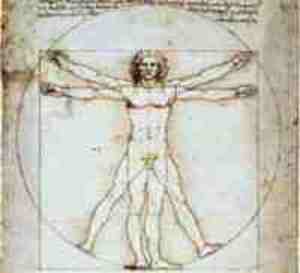Although it is certainly one of the most famous drawings in the world, most admirers of Leonardo da Vinci’s famous multi-limbed man are not even aware of what it is referred to or why. Based on the belief in a system of ratios used in antiquity for the construction of “perfect” buildings, this striking depiction is entitled Vitruvian Man and is named after Marcus Vitruvius Pollio, a Roman architect who wrote a series of works which survived into the Renaissance. These works helped form the basis from which Leonardo approached his great work, an image that not only best exemplifies Leonardo’s sharp sense of proportion; it is also seen to be the starting point of what would be Leonardo’s never-ending attempts to relate man to nature.
Vitruvius’s works were themselves based upon the ideas of the Greek philosopher Pythagoras. Pythagoras had seen the connection between music and numerical order and this lead him to reason that geometry itself was somehow sacred. He believed that numbers had inherent qualities and that geometric figures even possessed powerful magical qualities, i.e. they were actually magical symbols themselves. Specifically, he saw the circle, tied as it was to the continually circling stars and planets, as representative of the soul. On the other hand, he saw the square to represent the physical world, or at least how humans related to it. After all, there were the four seasons, the four elements, the four corners of a room or house, etc.
Pythagoras then concluded that the human body is itself a construct of both these magic symbols and held that it was geometric proof of what he saw to be humanity’s dual, divine nature. Much later, Vitruvius applied this same type of thinking to the construction of buildings and temples. And through his writings, he was Pythagoras’ mediator to Renaissance philosophy and Leonardo’s waiting, inquisitive mind. It was then up to the great Leonardo himself to prove this dual nature “in nature” by famously fitting the human body inside the drawing’s circle and square.
Renaissance artists before Leonardo had tried to visualize this dual soul/material concept but were far less successful with their drawings. It took someone of Leonardo’s genius to realize that the perfectly proportioned human body must be drawn first, only then can it be made to fit within a circle and a square – which must touch each other at the base of the drawing. It also took someone of Leonardo’s genius to come up with what was a very simple geometrical construction for the drawing. It is based on the square itself, which is then duplicated and rotated for 45º to form an octagram. The distance between the base line of the first square and the apex of the imaginary rotated one represents the diameter of the circle.
But what is perhaps more important here, Leonardo consistently followed his instinct and provided with this drawing a prime example of the way one can achieve perfect proportion using both scientific and artistic methods. And like the true scientist he was, he most likely achieved this through a substantial amount of trial and error: “If you open the legs so as to reduce the stature by one-fourteenth and open and raise your arms so that your middle fingers touch the line through the top of the head, know that the center of the extremities of the outspread limbs will be the umbilicus, and the space between the legs will make and equilateral triangle.”
This drawing is not only fascinating, almost hypnotic to look at. It also forms a bridge between symbols that are fundamentally religious and methods that are purely scientific, successfully bringing those two disparate worlds together and making them indivisible. This is of course no simple feat and is therefore quite a rare occurrence “in nature.” Yet these two opposite worlds, or so often thought to be anyway, are clearly complimentary opposites here. One cannot exist without the other. So by putting a square peg in a round hole, Leonardo’s drawing was not only a success, it continues to radiate an aura of indivisible wholeness that will most certainly never lose its appeal.
Reference:
- leonardodavinci.stanford.edu/submissions/clabaugh/history/leonardo.html
- www.absoluteastronomy.com/topics/Vitruvian_Man
- thealchemicalegg.com/VitruviusN.html
